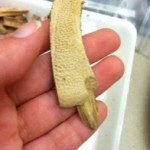Dr. Deanna Grimstead, Associate Professor in the Department of Anthropology of The Ohio State University, and her students are currently working with an Ohio Historical Society Collection from the Proctorville Village Site (Ohio Archaeological Inventory number 33LE12, collection A4197). The collection stems from a 1989 salvage excavation at the location of a large Fort Ancient Village located in Lawrence County. The goals of this project are 1) to use the collection for an introductory undergraduate and graduate level archaeological laboratory methods course, 2) to conduct a thorough zooarchaeological analysis of the archaeofaunal materials from the site, and 3) to further many more collaborative projects between the Ohio Historical Society and The Ohio State University. As part of the course students are giving the opportunity to blog about what they are learning and discovering. The following is the fourth submission and we hope you enjoy the student’s journeys as much as we will!
Ciao Ohio Historical Society Archaeology Readers!
We have come across some very interesting artifacts within the past few weeks and I would like to share them with you all! First, I want to mention turtles. Yes, turtles! We have found many numerous pieces of turtle shell and possibly a few turtle bones, mainly just pieces of the shell (Figures 1 and 2). There is the obvious explanation: that the Fort Ancient people were eating turtles. I found a piece of burnt turtle shell which could be evidence that these Native Americans were cooking the turtle in the fire and then cracking the shell open to eat. Or the meat could have been removed from the shell and then the shell was thrown into the fire (an example from today would be if you dropped your marshmallow at a camp fire instead of  eating it you would throw it into the fire).
eating it you would throw it into the fire).
I also googled what could turtle shells be used for and came across another interesting proposal. According to my Professor (Dr. Deanna Grimstead) it was also common for turtle/tortoise shells to be used in rituals or as a cup (for drinking purposes). There is evidence that the Fort Ancient people played musical instruments and maraca type instruments are popular throughout the world so why not here in early Ohio history as well? This website suggested that turtle shells could be filled with pebbles and could have been used as rattles (1). One of the items that I found while doing my lithics analysis was a piece of sandstone (Figure 3). If I am being honest, for a moment I was super excited because I thought that I had found a piece of gold. But after I took a moment to look closely at it, I realized it definitely was not gold and my professor confirmed that it was sandstone.
After I found out that it was sandstone, I wondered how did it get here? Where would it have come from? What would they have used it for? At first, I thought that sandstone must come from down south, where there is more sand. However, we have our own source of sandstone in northeastern Ohio, also known as the Borea formation. Northeastern Ohio is a long way from Proctorville (like across the state of Ohio far) , which suggests that either sandstone was used for very special things, because they only made that journey a few times, or it could have been traded. Sandstone also could have occurred in the area due to natural geological processes or by being transported by a stream or river. The actual sandstone itself was used either as an abrader, which can be used to smooth down and polish surfaces. Smoking pipes could be made out of sandstone as well (2). While I don’t have any definite answers because I didn’t live in the time of the Fort Ancient I definitely had fun reading articles and speculating how these people would have used turtle shells and sandstone.
, which suggests that either sandstone was used for very special things, because they only made that journey a few times, or it could have been traded. Sandstone also could have occurred in the area due to natural geological processes or by being transported by a stream or river. The actual sandstone itself was used either as an abrader, which can be used to smooth down and polish surfaces. Smoking pipes could be made out of sandstone as well (2). While I don’t have any definite answers because I didn’t live in the time of the Fort Ancient I definitely had fun reading articles and speculating how these people would have used turtle shells and sandstone.
-Lauryn Platt
1)http://westernreservepublicmedia.org/onestate/lp1gansw.htm